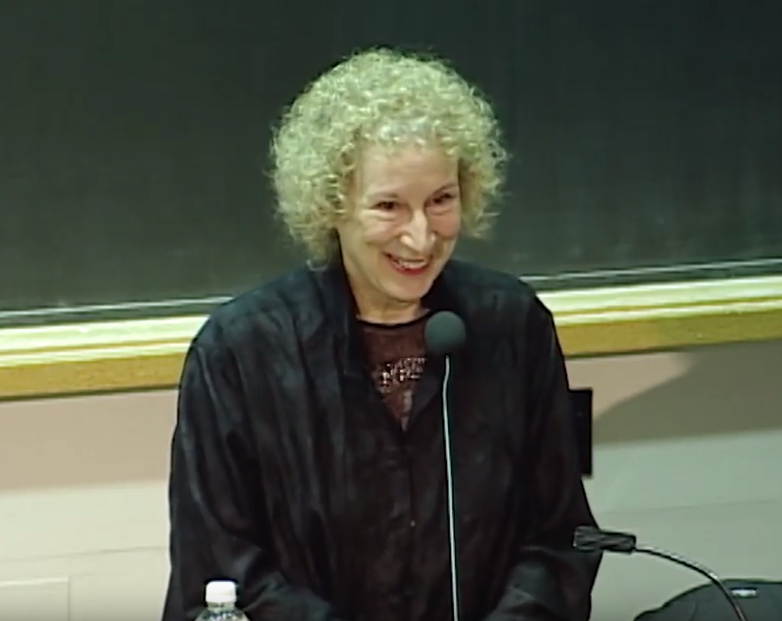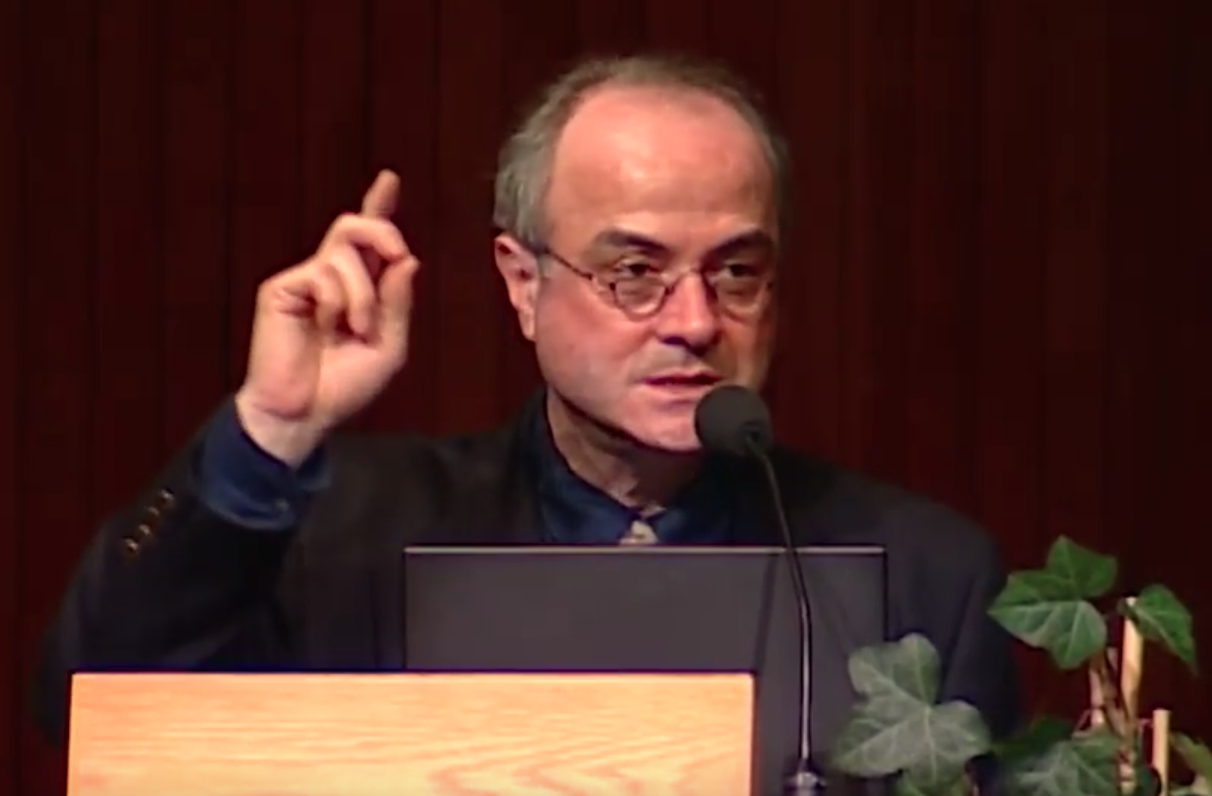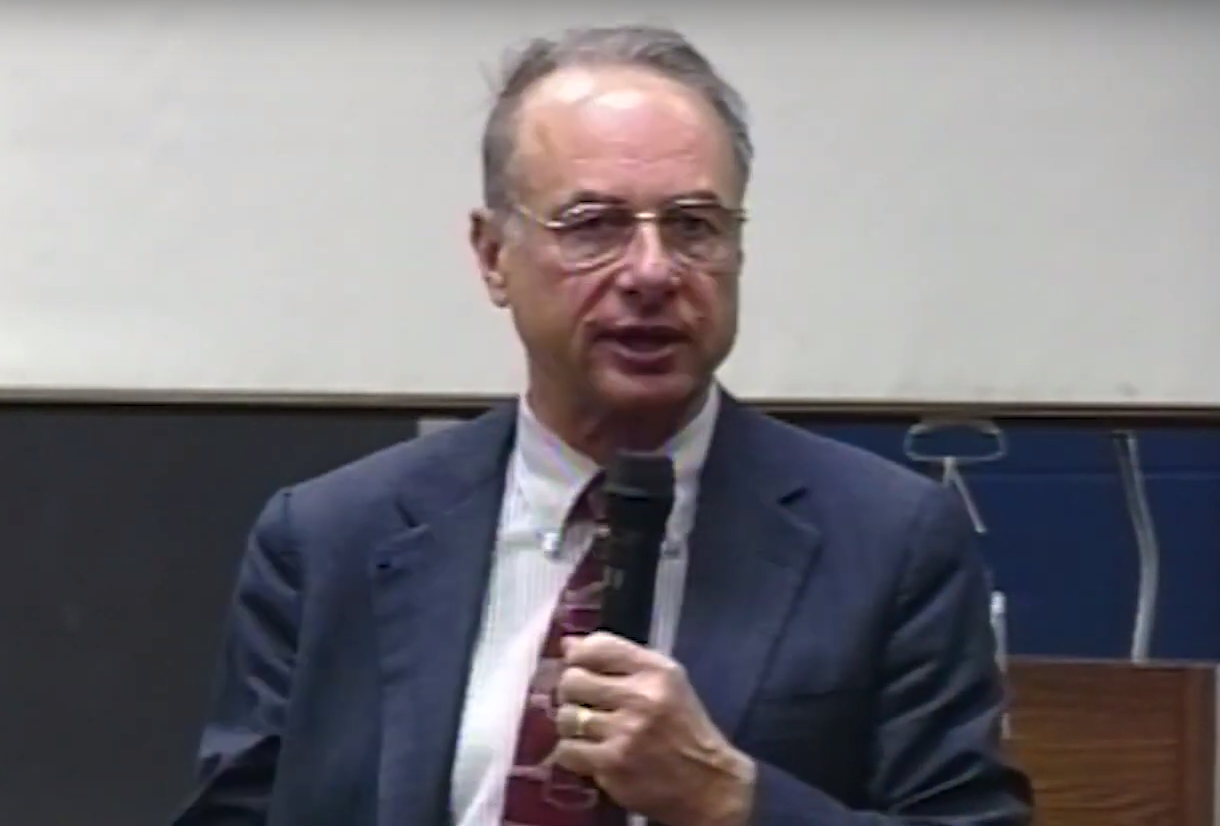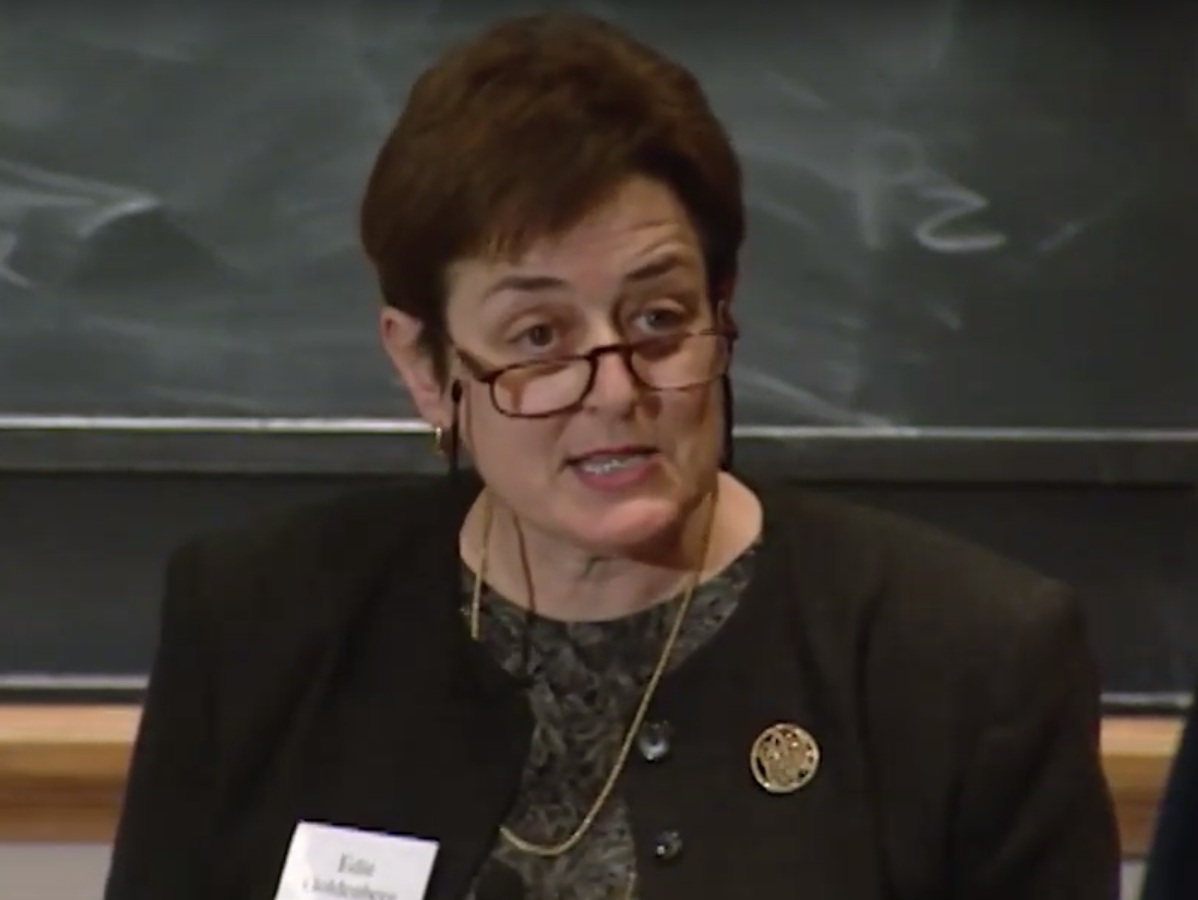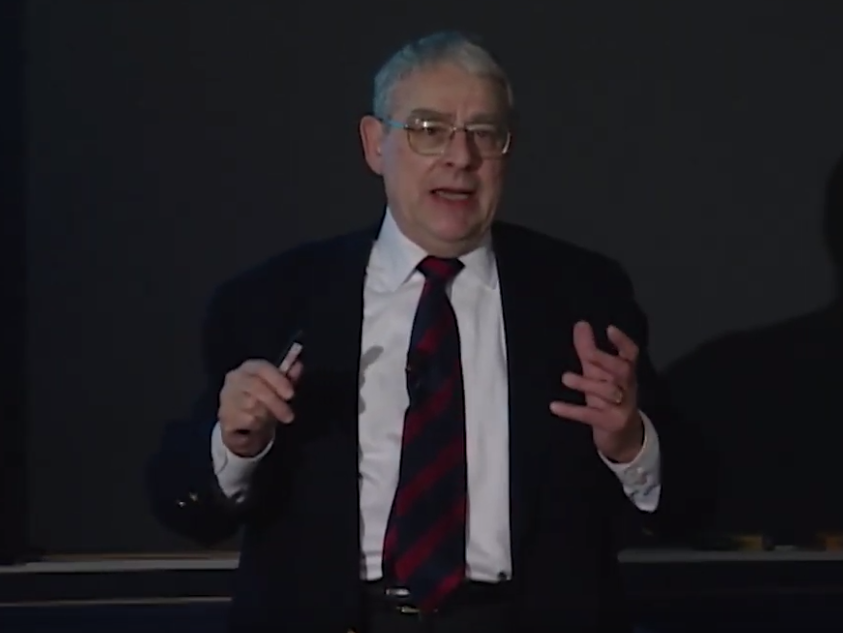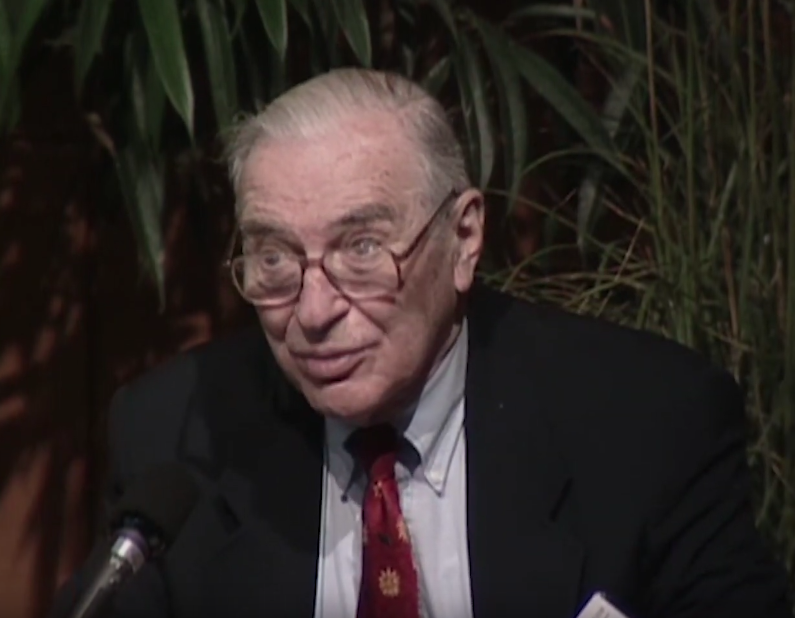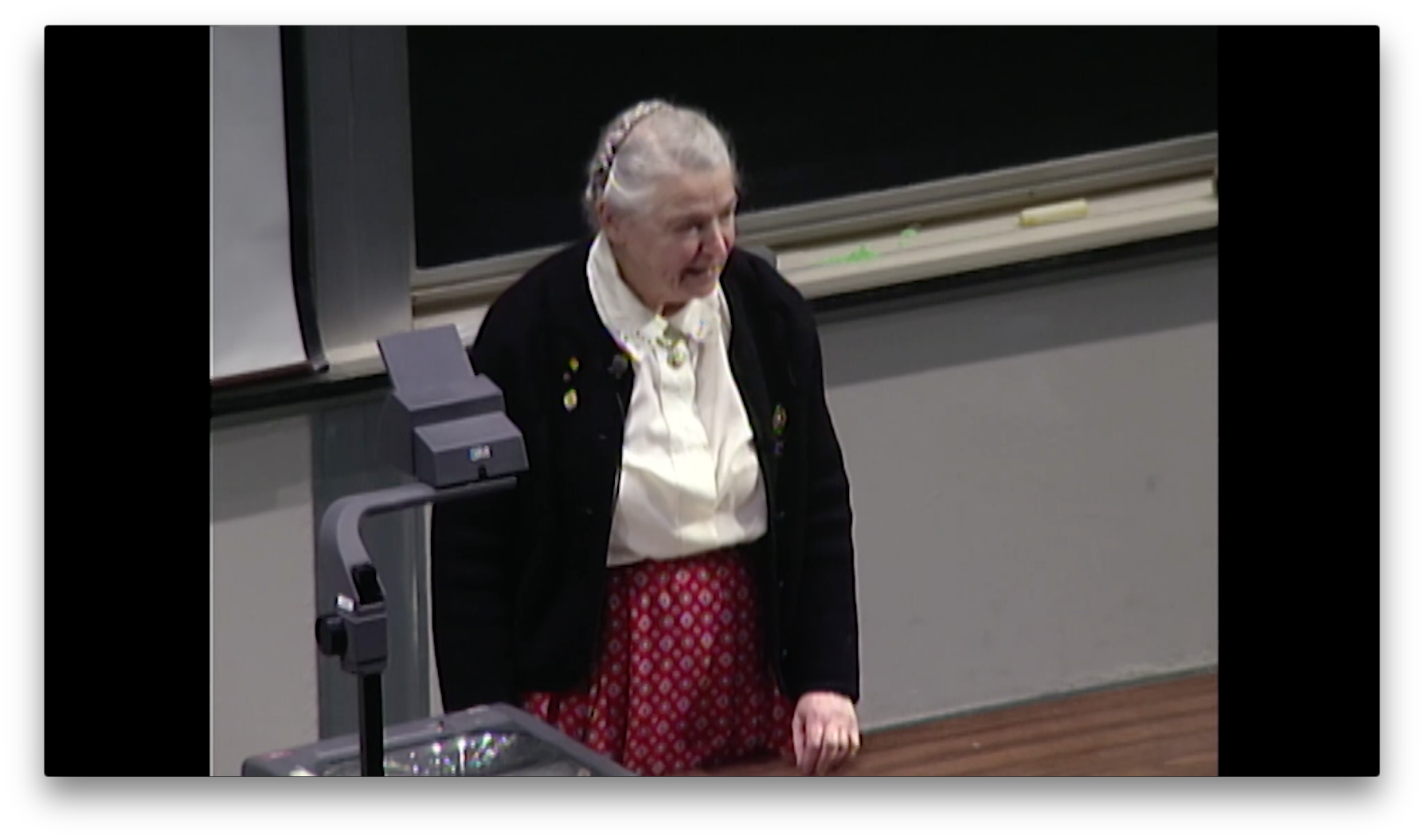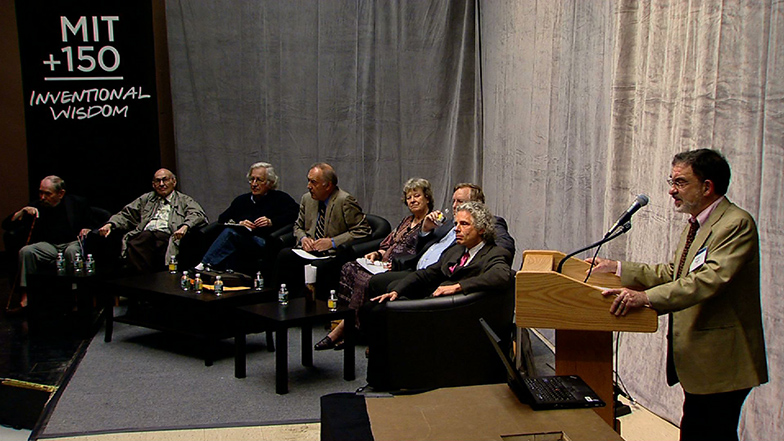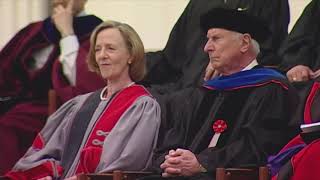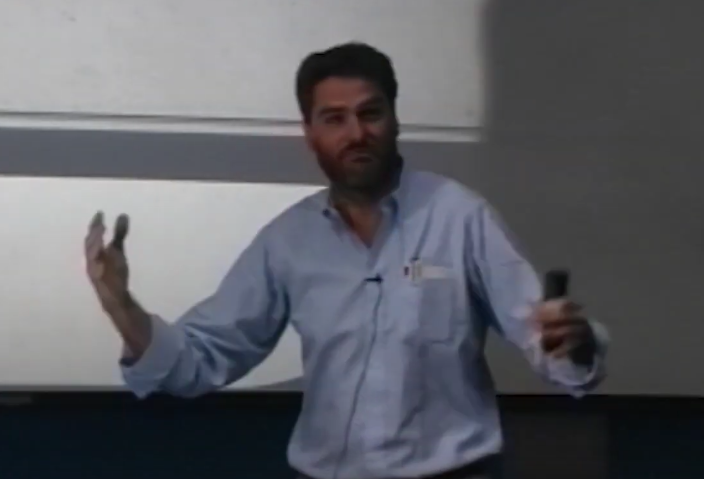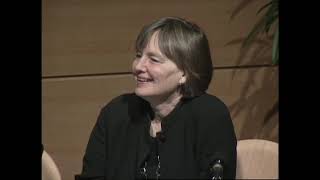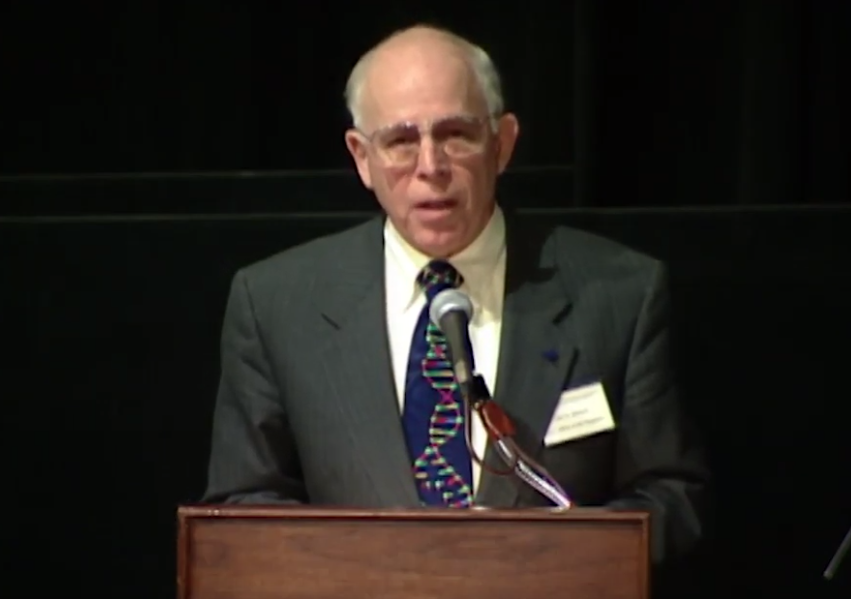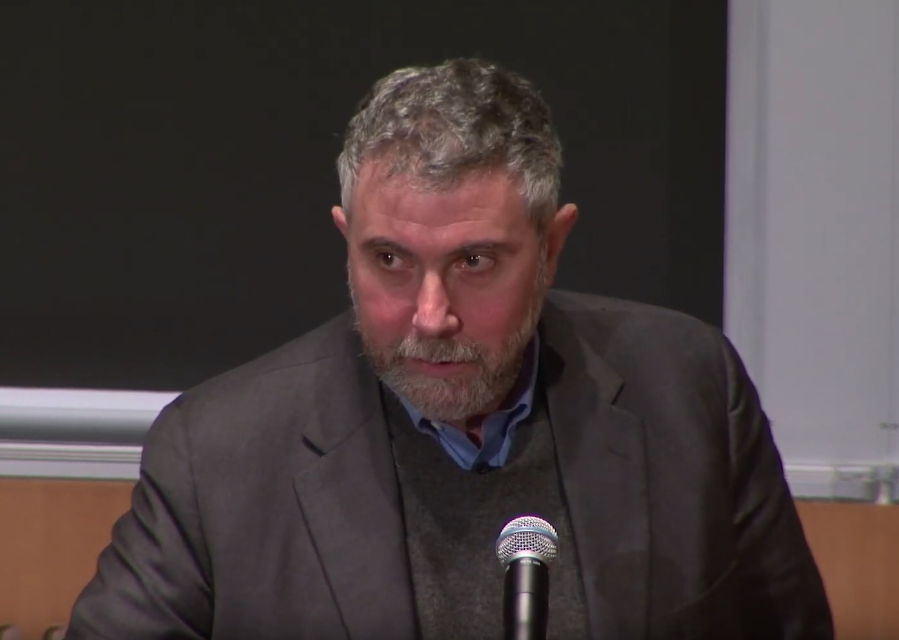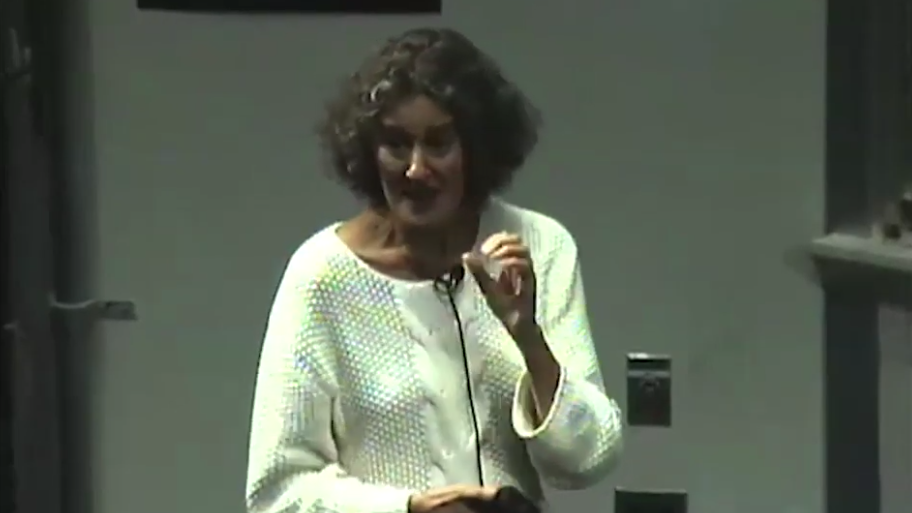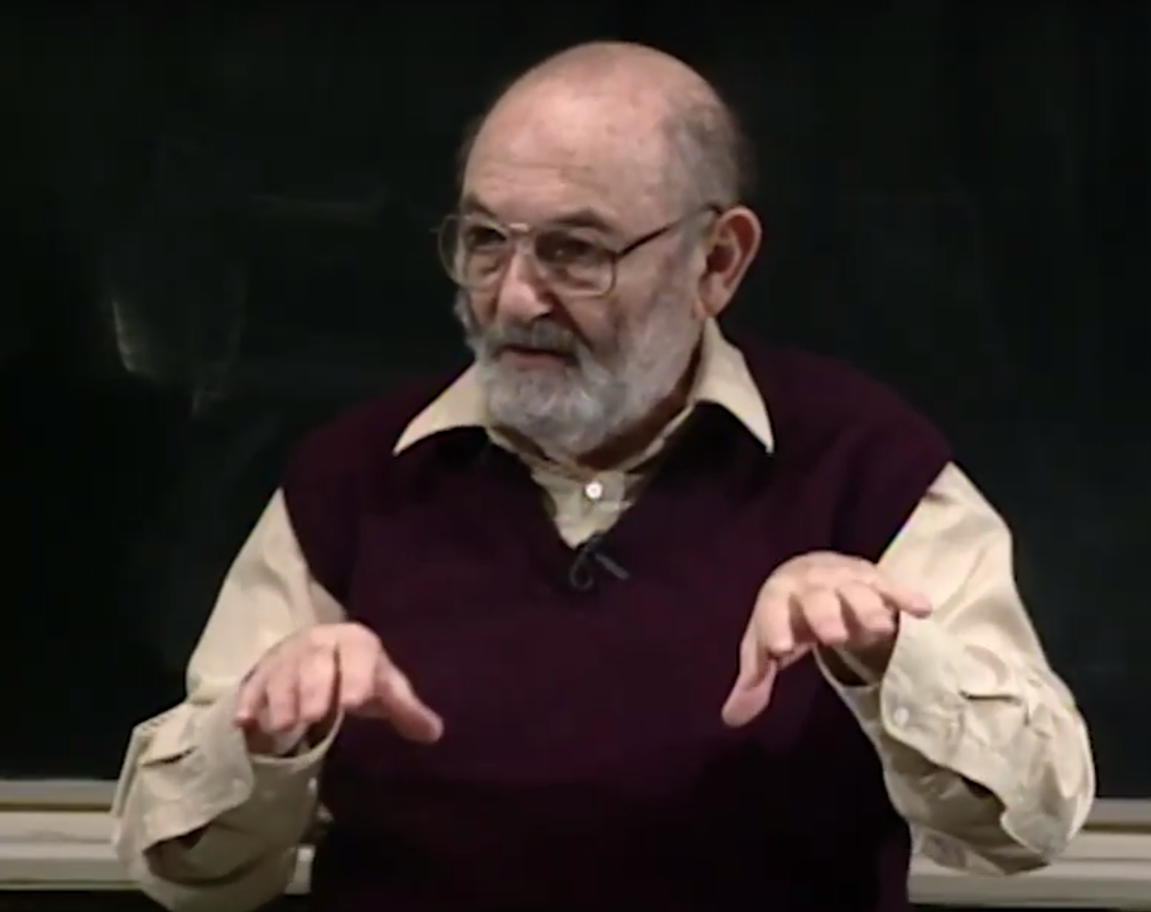Ira Herskowitz & H. Robert Horvitz - Biology, Genetics, Cells - MIT Whitehead Institute
[MUSIC PLAYING]
IAN HERSKOWITZ: It's a great pleasure to come to the Whitehead, and to MIT, and to take part in this wonderful symposium. It's a great challenge to speak here, too, for several reasons. For example, Doug Melton asked for a complete transcript of my talk. That's the first time in history.
Secondly, Bruce Springsteen, I think, wrote a song about giving a talk here. He called it "Blinded by the Lights." Another thing that makes it difficult to speak here is that as I was trying to put in my slides, the other speakers were having to pass judgment on the number and quality of the slides. And it's a pretty tough group.
Finally, we heard about the Whitehead Curse last time, about having newspaper reporters call in the middle of the night. That wasn't a problem. Now, this morning's session and the meeting has to do with cell-cell interactions and the diverse biological roles that they play.
And that's one of the things I really like about this symposium-- why I'm learning a lot and we'll learn a lot-- because it really represents a lot of different organisms. And everybody here has their own favorite organism or two. But let me also say, even though we have favorites, we're not chauvinistic about the organism.
Larry [? Zipursky's ?] very fond of drosophila. I love yeast and corn smut. Bob Horvitz likes nematodes. And people like Doug Melton and Marc Kirschner are known for running around kissing beautiful women and hoping they'll turn into frogs.
At any rate, I'm going to discuss the roles of cell signaling in two organisms-- the familiar baker's yeast, budding yeast, and also a less familiar organism-- one of the basidiomycetes that Mike Brown mentioned yesterday-- in this case, ustilago maydis. And the first half will be on budding yeast. The second half will be on ustilago maydis.
And let me just say that in examining the lifecycles of these organisms, what we're going to see is the roles of different types of molecular machinery in programming their lifecycle. And the two molecular machinery that I'm going to talk about-- the first one is regulatory proteins. And the second machinery that we'll talk about are cell signaling systems.
So in both cases, we'll see the role and the interplay of gene regulators and cell-cell interactions and programming different parts of the lifecycle. Also, I want to describe genetic control and, to some extent, environmental control of cell morphogenesis in these two organisms. And so there will be a lot of links between the two organisms. I'll probably present too much information, but I hope that the overview of these two organisms will come across.
So the first organism you're familiar with is budding yeast. And there are three cell types in this organism-- a-cells mate with alpha cells. Alpha cells mate with a-cells. And the a/alpha diploids, the product of the mating, and it does not mate with either cell type. But it undergoes meiosis.
So these play roles in the lifecycle of the organism. And these specializations of these organisms come about by natural alleles-- MATa, which programs the a-cell type, and MAT alpha, which programs the alpha cell type. The mating type loci alleles code for three regulatory activities. Alpha 1 is a transcriptional activator. It's a positive regulator. It turns on transcription of alpha-specific genes.
Alpha 2 is a negative-- is a repressor, which turns off a-specific genes. And a1 alpha 2 is another repressor, which turns off another set of genes, the haploid-specific genes. Just to demonstrate alpha 2-- in an alpha cell, the alpha 2 protein is a repressor-- and this is a low-resolution view-- and it binds to the upstream region of all these genes, which are genes that are important for a-cells to mate-- receptors, et cetera-- mating factors.
So this is a low-resolution view of alpha 2. Here's a high-resolution view done by Cynthia Wolberger and Carl Pabo's lab in collaboration with Sandy Johnson. Alpha 2 is a homeodomain protein, which binds the DNA in essentially exactly the same manner as engrailed protein binds the DNA.
Now, a particular regulator that I want to call your attention to, because something like it will show up in the second half of the talk, is a1 alpha 2, which is the molecular signature of this cell type-- the a/alpha cell type. a1 alpha 2 is a heterodimeric repressor. Work from [? Carolyn ?] [INAUDIBLE] and Sandy Johnson's lab shows that this repressor has two subunits, a1 and alpha 2. And it binds the DNA, more or less, in this manner.
And in so doing, a1 alpha 2 represses many genes. It's a repressor with many target genes. It turns off transcription of HO show gene. It turns off transcription of a whole herd of genes that are involved in cell signaling. That's important for haploids. It turns off a retrotransportable element, turns off the genes involved in cell fusion, et cetera.
Now, that's the regulatory proteins. They turn on and turn off the appropriate genes. But cell specialization, the differentiation process of yeast, occurs in its full form only at the appropriate time-- only when a cell sees its mating partner. So an alpha cell turns on the final differentiation of an a-cell. And the a-cell turns on final differentiation of an alpha cell.
And they do that by secreting peptide mating factors. Alpha-factor is 13 amino acids, and a-factor is 12 amino acids with a modified cystine-- the farnesylated cystine. And it's hydroxymethylated as well. So they act extracellularly to turn on the final differentiation.
Now, alpha-factor causes the target cells to do three main things-- to arrest in G1, to undergo morphological changes, and to turn on transcription of a whole bunch of genes. So alpha-factor is a differentiation factor. It's a negative growth factor, and it's turning on the final differentiation of the mating partner. And I want to comment quickly on the mechanism of transcriptional induction and then G1 arrest.
So alpha-factor causes arrest here in the cell cycle, in G1. And this demonstrates how we assay that in the lab. This is a patch of alpha cells. And the alpha cells are inhibiting growth of the lawn. The lawn is a bunch of a-cells. And you see that there is a zone of inhibition here, as the alpha cells inhibit the cells in the lawn.
Now, this shows you alpha-factor has a potent effect on cherry tomatoes. This is without alpha-factor. This is with alpha-factor. Now, the machinery for response to mating factors is shown here. Each cell has a specific receptor. Alpha cells have a receptor that allows it to respond to the a-factor.
A-cells have a receptor, which allows it to respond to alpha-factor. We know the genes that encode these receptors, and they're regulated in a cell type-specific manner. Only alpha cells have this gene expressed. Only a-cells have this gene expressed.
And all the intracellular machinery is the same in both a-cells and alpha cells. And that can be shown by doing receptor swap experiments. So that's what's on the cell surface. Now, let's look inside the cell and see what the machinery is.
So here on the left is an unstimulated cell. We have the receptor is the seven membrane-spanning type. And it has its associate-- its sidekick, this heterotrimeric G protein, which exists in the GDP-bound form. And in the end stimulated state, the FUS1 gene, discovered in [? Gerry ?] Fink's lab and involved in cell fusion, is off.
And the G1 cyclines, important for cell cycle progression, are active, so the cells cycle. They grow vegetatively. Now, in the presence of alpha-factor-- alpha-factor binds to the receptor. It somehow causes it to exchange to a GTP form of alpha. And now the heterotrimer falls apart, in this case, liberating a beta gamma subunit, which then triggers the pathway.
And a lot of these steps have not been worked out biochemically. But there is progress being made literally every day. And I'm giving you sort of the best guess of the pathway right now. Beta gamma somehow stimulates sterile-- let's go to the end of the pathway and show that at the end of the pathway, the FUS1 gene, which used to be off, is now-- its transcription is now stimulated.
And the FAR gene, whose protein inhibits CLN1 and CLN2, is turned on. And it causes cell cycle arrest. And these genes are transcribed because sterile 12, the transcription factor, has become active. And it's become active because upstream are some protein kinases-- FUS3, again, discovered in the Fink Lab by Elaine Elion.
And these proteins, MAP kinase relatives, somehow activate sterile 12, presumably by phosphorylation. Sterile 7 is almost certainly the MAP kinase kinase. And sterile 11, one could argue, is a regulator of sterile 7-- so another protein kinase.
So beta gamma triggers a series of protein kinases to then activate a transcription factor, which then turns on transcription of a whole bunch of genes important for the mating process. So that's why the final differentiation occurs only at the right time, because the mating factors trigger that differentiation.
Now, to progress from G1 to S, one requires a protein kinase, p34, with its appropriate cyclins. Likewise, to proceed from G2 to M, one requires an active protein kinase. And in budding yeast, there are G1 cyclins that are necessary for this activity. Now, I want to just say, briefly, the reason for arrest in the yeast case is FAR, which is identified by Fred Chang.
And now we know quite a bit about how FAR acts. And I don't have time to show you the data, but this is the essence of what we now know about the regulation and activation of FAR. Once again, there is a MAP kinase kinase, sterile 7, which phosphorylates these MAP kinases. This has been shown now from Beverly Errede, Gustav Ammerer, and Kim [? Naismith. ?]
Somehow, sterile 12 is activated. That turns on FAR. Now, the FAR protein by itself is not functional. Rather, FAR protein is phosphorylated by FUS3, as shown in my lab in vivo by Matthias Peter and in Gustav Ammerer lab in vitro. So FAR1 is phosphorylated.
In its phosphorylated form, FAR1 is associated in a complex with CLN2 and CDC28. And it's this complex-- so FAR then inhibits this activity, either by directly inhibiting the activity or by causing CLN2 on to become unstable. At any rate, the important point is that FAR associates with these only when its phosphorylated and thereby inhibits their function.
Now, this is an overview of the cell signaling pathway. Jerry said we should find common features in these different signaling systems. And this is one way of thinking about it. An overview of the mating factor response pathway-- in the presence of alpha-factor, you have an activated receptor. And then there are a whole herd of protein kinases, which act to phosphorylate in a cascade.
But also, there are some complex epistasis relationships in yeast, which indicate that maybe there's some phosphorylation of each other in complicated ways. At any rate, they then do a variety of things. They have multiple substrates. They have a lot of different targets.
And so the cell can do a lot of things, including activating a transcription factor. And of course, a transcription factor can have multiple targets. Meanwhile, back at the ranch, the protein kinases can be turning off-- can be involved in desensitization adaptation. So you see that really with just a simple molecular machinery-- protein kinases and transcription factors-- one can program a cell to do a lot of different things.
Now, the last part of the description of a budding yeast, I want to give some comments about morphogenesis and how it's programmed genetically and how that can be influenced environmentally. The yeast cell, budding yeast, makes a bud. And this bud, the yeast cell, has a lot of polarity. And that's reflected in the arrangement of the different cytoskeletal components.
For example, actin filaments are arranged in this manner. And there are actin dots in the bud and near the neck. All cell surface growth is here. And that's presumably because this is orienting vesicles to be delivering their contents to the daughter bud. And then finally, there are microtubules-- extranuclear microtubules emanating from the spindle pole body, which point towards the new bud.
How is that polarity of a yeast cell orchestrated or programmed? Well, it turns out that it was of immediate interest to us because it's different, depending on the cell type. So in a-cells or alpha cells, the first bud comes out like this. And the next bud typically comes out near the axis of where it had divided previously.
In the a/alpha cell type, in contrast, the next buds typically come out from the ends, or sometimes, one comes near the junction. That's the bipolar pattern. So we'd like to understand how the mating type locus programs the different planes of cell division here. In this case, it switched to be in this direction here. It maintains in this direction.
This is a picture of the axial pattern. This is the axial pattern exhibited by alpha/alpha diploids. They're alpha cells, and they give axial pattern. Here are a/alpha cells, and they give this elongated pattern here, budding from the ends.
Now, the ability to bud in a characteristic manner reflects some interesting reorganizations that take place during the cell cycle. If we look at the end of mitosis, where the spindle pole bodies are at opposite poles here, we see that in an a-cell or an alpha cell, where the new bud is going to come out here near the junction of the previous ones-- it's known from work of Breck Byers that the spindle pole body is oriented towards the bud.
Let me just say right now, we don't think the spindle pole body is saying where to make the bud. We think it's following instructions from something that's at the side of the new bud. At any rate, we know that the spindle pole body does have to move. And that process occurs in an a-cell or an alpha cell.
But notice, in an alpha cell, much of the time, the spindle poles, having gone to opposite poles at the end of mitosis, can just sit there. They do not have to undergo this movement here. Although, sometimes this one does move in the mother's cell. So there's some kind of regulation of movement of the guts of a cell.
Now, John Chant-- who's, within a few months, going to take a position in Doug's department-- as a graduate student in my lab, began a very prolific attack-- or productive attack on this problem by looking for mutants that are unable to exhibit this phenotype. He looked for mutants that did not give the axial phenotype. They were defective somehow in this process.
And the mutants turned out to have two different phenotypes. In some cases, the mutants exhibit a bipolar phenotype. In other cases, they exhibit a random phenotype. And thinking about-- and these are all due to knockout mutations-- to loss-of-function mutations.
So we arrange this information into a morphogenetic hierarchy here and say that they're-- this is one view. I'll show you another view on the next slide. There's a random pattern, and that gets converted to a bipolar pattern by the action of bud 1, 2, and 5. That gets converted to an axial pattern by bud 3 and bud 4.
The major point I want to make here is that we can propose a hypothesis for why a-cells, which give an axial pattern, differ from alpha cells, which give the bipolar pattern. And that resorts to our knowledge that a/alpha cells have a repressor, a1 alpha 2. So we can propose simply that a1 alpha 2, in addition to turning off HO, and TY1, and transcription of many genes involved in the mating pathway, turns off bud 3 or bud 4.
And you see, bud 3 or bud 4 are necessary to give axial pattern. So if a1 alpha 2 represses bud 3 or bud 4, or somehow, their activity, then one gets a bipolar response. So this shows how the mating type locus can control morphogenesis and the plane of cell division in yeast. And I'll come back to that with ustilago.
This is an update, because as I have looked at this pattern for a year or so-- and you look at it too much, you start to believe it, even though there are other ways of thinking about it. And here's another way of thinking about it. Another possibility is that there is, again, a bipolar pattern and an axial pattern, and that bud 3 and bud 4 are necessary to convert this to this.
But you could also say that either one of these patterns can decay and that bud 1, 2, and 5 lock these patterns into position. We really don't know exactly the molecular machinery-- how bud 1, 2, and 5 work to program the pattern. But in the last few minutes of this first part of the talk, I want to give you an update on the molecular machinery that bud 1, 2, and 5 genes define.
But before I do that, let me say something about another group of genes involved in budding pattern. This is a group of genes-- and this work is really based from John Pringle's lab-- a group of genes typified by CDC24, which has the phenotype that at non-permissive conditions, instead of giving a bud localized growth, it undergoes uniform cell surface growth. So these genes-- CDC24, 42, 43, and BEM1-- are all necessary to restrict growth to a certain point.
Now, CDC42 is a member of the Rho family, so it's a small, low molecular weight GTP-binding protein. CDC43 is a subunit of a geranylgeranyl aiding enzyme, which, I think, has been shown to prenylate CDC42. I'll talk about BEM1. CDC24 is a guanine nucleotide exchange protein.
Now, the idea then is that the bud proteins, which are important for telling the cell where to make a bud, organize these proteins here, which define the budding site-- which restrict budding to one position. And the hypothesis is that these proteins organize the cytoskeleton actin and tubulin. And we don't have any direct evidence on this-- any biochemical evidence.
But we and John Pringle's lab-- that has Janet Chenevert in my lab and Kathy Corrado in Pringle's lab-- sequenced BEM1 and showed that BEM1 has two SH3 domains, which are thought to be involved in organizing actin. Although, they may not do it by directly binding to actin. So the idea then is that the bud proteins, bud 3 and bud 4, recognize a landmark at the old junction between mother and daughter.
And then bud 3 and bud 4 somehow organize the other proteins-- the CDC24, et cetera-- to that site, and then they ultimately organize actin and tubuline. Now, we know something about bud 1, 2, and 5. And I want to go into this because there's now a new regulation at the NIH that everybody has to work on low molecular weight GTP-binding protein.
So you see the impact on the Brown and Goldstein lab. They no longer work on cholesterol. It's all [INAUDIBLE] and stuff like that. OK, they're cringing in the first row.
OK, so it turns out that bud 1 is similar to RAS. That was shown by Alan Bender and John Pringle's slab It's a RAS relative. And bud 5, John Chant sequenced and showed that there's similarity to CDC25 in [INAUDIBLE], which is a guanine nucleotide exchange protein. So the idea then is that bud 1 as two states, and those are switched by bud 5.
More recently, Hay-Oak Park, a postdoc in the lab, sequenced bud 2, which was cloned by John Chant. It has similarity to GAP proteins. And Hay-Oak has now shown that bud 2 has Gap activity against bud 1 in vitro. So we, too, do enzymology, not just Goldstein and Brown.
So we have bud 1 has two states, a GDP-bound form and a GTP-bound form. And there's a bud 5, which is proposed to catalyze nucleotide exchange, and bud 2, which looks like a GAP. What do these proteins do? This is a hypothesis. We really don't know how they interface with the rest of the proteins.
But the scheme is as follows-- is that bud 1 may be involved in bringing important proteins to the budding site. For example, perhaps the GTP-bound form interacts with CDC24. It brings it to the budding site. Once at the budding site, bud 1, which, let me just comment, has a CTIL at its carboxy-terminus, and so it's likely to be geranylgeranylated.
So bud 1 brings us here. And now, at this position, the bud side-- maybe bud 2 is located here. The gap protein causes hydrolysis to GDP. Bud 1 can exit, leaving behind CDC24, get recharged, et cetera.
So the idea is that there is a cycle of interchange between bud 1 and 2 modes, which may be involved in assembling some process or in locking in some morphogenetic step at the budding site. That's the working hypothesis. Obviously, we need now to put up or shut up and find out what bud 1 interacts with.
Let me just leave the morphogenesis process and bring it back to the idea of cell-cell interaction by noting that yeast cells orient their cytoskeleton in response to their mating partner. We've just seen that yeast cells growing vegetatively have a programming of where to bud. They bud axially. They bud in a bipolar manner, depending on what their cell type is.
But the interesting thing is that when two cells-- a-cells and alpha cells come near each other, they reorient their cytoskeleton towards each other. So it appears that there's some kind of morphogenetic signal that is generated by cell-cell interaction so that the yeast cell reorients it's cytoskeleton. So now, they orient the cytoskeleton towards each other so that at the time the cell fusion, there's an appropriate nuclear fusion involving subunits of the nuclear membrane and the spindle pole apparatus.
Now, in summary then, I've talked about two different morphological forms of yeast. The haploid gives axial budding. The a/alpha cell gives bipolar budding. And in Jerry Fink's lab, [? Hemeno ?] et al. have shown that when a/alpha cells are starved nutritionally, they undergo another form. They have extreme elongation and accentuation of elongation.
And they don't undergo cell separation. So they make a pseudohyphal form, which they argue00 and it's a rational proposal-- is involved in foraging. So these are the three different morphological forms of yeast. And this is an introduction then to the next part of my talk, which concerns ustilago maydis.
Now, ustilago maydis-- I will show you that it has a lot of the same machinery as in budding yeast. It's got homeodomain proteins, and it's got signaling systems, and pheromones. But it deploys all this machinery in a slightly different way. And every time you think you understand ustilago, and you base your thinking on how yeast does it a certain way, ustilago trips you up.
So don't make any assumptions. This is an organism from Mars, really. It's a very interesting one. It's a fungal pathogen of corn. It's a member of the smut fungi, which cause a variety of disease-- in this case, on corn.
The disease is characterized by tumors on leaves, stems, and cobs. The host ranges on corn and teosinte, but not on other relatively close relatives, like millet. And it needs the plant to complete its lifecycle, as I will show you.
There's a developmental switch in this organism. They're haploid forms, which are yeast-like. They're unicellular, they grow on plates, and they're non-pathogenic. And they mate to form a dikaryon, which is filamentous. This is the pathogenic form, and it needs the plant to complete its lifecycle.
And I'll go into detail in a moment, but there are two lifecycles that are needed-- two mating-type loci that govern its lifecycle. The a-locus has two alleles, a1 and a2. The b-locus has 25 alleles, b1 through b25. And in order to complete its lifecycle, cells have to differ at both loci.
And the work on ustilago-- there's been a rejuvenation or influorescence on this organism by these people. Sally Leong and Madison developed transformation. Flora Banuett at UCSF has been doing genetic analysis and cloning the mating-type loci, as have these other people, and done other work I will show you.
Regine Kahmann has been cloning the mating-type locus, partially in collaboration, and has also cloned and characterized the a-locus. So these are the people that are responsible for a lot of information about this organism in the last five years. All the photos I will show were taken by Flora Banuett.
This is the haploid form of ustilago. It's more elongated than [INAUDIBLE]. And here's a bud, and you see it has one nucleus. After mating, there's a filamentous form produced, and you see this filament has two nuclei. It's a dikaryon.
And here is a whole bunch of more filaments. And this is an assay on Petri plates where filament formation is seen by formation of this white fluff. Here are more filaments. Now, this is a very interesting photo, which shows a haploid cell here. You see its haploid nucleus.
And here you see some cells that are mating. Here's one nucleus. Here's another nucleus. Here's a dikaryon here. And this shows an intermediate in the mating process. So the cells mate with each other to form the dikaryon.
Now, as I'll mention, the a-locus-- in yeast, the mating-type locus codes for regulatory proteins. And the mating pheromone genes are scattered throughout the genome, and the receptors are. What Regine Kahmann's lab found is that the a-mating type locus actually codes for the mating pheromones and the receptors.
And these mating pheromones and receptors then, presumably, facilitate the mating process. And then later, you get the filamentous dikaryon. So here's the lifecycle. You form a dikaryon. The dikaryon infects the plant. Now, it causes tumor formation in the plant.
And Jeff Schell will be talking about what agrobacteria does to a plant, among other things. And in this case, ustilago causes tumors in corn. But nobody knows the molecular mechanism. So it turns on tumor formation. And within the tumor, the fungus differentiates.
So this is one example of cell-cell interaction. It differentiates within the plant to make teliospores. And these are diploid spores. And then when they germinate, it undergoes meiosis.
So this shows you some of the actual tumors. This is on the leaf-- on the midrib of the leaf. This shows you why corn geneticists are not fond of ustilago. This is from Ginny Walbot's field, and this is an ear of corn that she was very happy to give Flora.
And these are, more or less, normal ears-- I mean, more or less, normal kernels. And these here are individual kernels that have been infected by ustilago. And then they're completely filled with sooty spores, and that's why they're called smut. And when young ears of corn are infected, they're actually a delicacy. Obviously, this is no delicacy.
This shows some tumors on a leaf. And you see that the tumors are formed, and there is also induction of anthocyanin. These are now some thin sections. And this beautiful color here is the anthocyanin, the purple color. This is the plant cell here.
And this is now plant cells, once again. But you see threads of the infecting fungus, and these are teliospores being formed here. These are later stages of teliospore development and the final stage of teliospore development. So there are two steps in the lifecycle that describe where there are cell-cell interactions. First of all, the fungus induces the plant to make a tumor.
And then within the tumor, the host induces the fungus to differentiate-- to undergo nuclear fusion and to differentiate into the teliospore. In no case are these signals known here. What we do know from the work of-- from cloning by Froehlinger and Leong and by cloning and sequencing from Regine Kahmann's lab is that the a-locus codes for a mating factor and a receptor.
And a2 alleles codes for another receptor and another mating factor. And as Mike Brown mentioned yesterday, the prenylation was discovered on fungal mating factors of a different basidiomycete. Tremella mesenterica was one of them-- a truly obscure organism where not too much work is done on the biology.
At any rate, this ustilago is also a basidiomycete. And lo and behold, it has mating factors which have all the hallmarks of those farnesylated mating factors. They're short, they have the [INAUDIBLE] box on the end, and it's not a [INAUDIBLE]. OK, they code for components of a pheromone response pathway, presumably important for cell fusion.
Now, that's just like yeast, except that the genes are at the mating-type locus. Now, this is a surprise. These pheromones and the response system are important for maintenance of this filamentous state. This is not obvious. So they're necessary for maintenance of filamentous state.
So the dikaryon needs to signal itself to maintain this state here. And the reason we know that is from Flora Banuett's observation that the a-locus is necessary for maintenance of the filamentous state. Doubly header zygote strains are filamentous. Strains that are homozygous for a are non-filamentous.
So somehow, the pheromones are triggering the proper morphological differentiation. We know that [INAUDIBLE] responses occur in a lot of cancer cells. And I don't know how common it is in normal cells. But it's something that I'm staying tuned for since it's cropped up here.
Now, the signal transduction pathway in this fungus, we think, is going to be similar to that in budding yeast and [INAUDIBLE] yeast. There are receptors identified from Kahmann's lab. And Flora has identified a gene, FUZ7, which is related to the presumed MAP kinase kinase, sterile 7, or BYR1. And she cloned the gene, and this shows you the similarity of FUZ7 to the other fungal protein kinases.
If she knocks the gene out, instead of getting this mating response, she doesn't get the response. So FUZ7 is important for the response to the mating factors in some way. And whether it's important for responding to plant signals is not known. Now, that's the a-locus. The a-locust codes for mating pheromones and for pheromones. The b-locus codes for regulatory proteins-- two regulatory proteins that are both homeodomain proteins.
The original locus was cloned originally by Common's lab, and by Flora Banuett, and by Leong and [INAUDIBLE]. And then the Common lab showed that there is another polypeptide coded at that locus. So there are two homeodomain proteins, called W and E.
These proteins have a constant region that's similar-- I'm not going to go into that. At any rate, they have a homeodomain protein. And the 25 alleles at this locus-- any combination of two different alleles results in pathogenicity. And this is a regulatory protein.
Deletion analysis-- mutational analysis by Common showed that the active species is a heterodimer of one W protein and one E protein-- for example, the W protein from the b1 allele and the E protein from a b2 allele-- so that lo and behold, the active species is a hetero-oligomeric protein.
So heteromeric regulatory proteins are a molecular signature for diploid cell type and budding yeast, a1 alpha 2, and for dikaryotic cell types, and fungi-- So E2W1 or E1W2 in u. maydis. And then and other fungi-- for example, the wood-rotting fungus-- guys at [INAUDIBLE]-- also had such a system. So fungi-- and yeast is a single-celled fungus.
Fungi make use of these combinatorial regulators composed of multiple different types of subunits to program their lifecycle. Now, what are the targets of regulation by the ustilago heteromeric protein? We'll call it b1b2 for simplicity.
So we know that cells that have b1b2 that are dikaryons have the following properties-- they induce tumors, they're filamentous, and they're saprophytic, which means they cannot grow on plates in the lab. So this regulatory protein here somehow activates tumor formation, and it activates filament formation, and it inhibits saprophytic genes.
Now, let's remember that this, at least in [INAUDIBLE], is a repressor. So we should at least keep an open mind and consider that maybe this turns on these processes by inhibiting an inhibitor. So this may be a repressor, which activates tumor genes by inhibiting z. And Flora has identified mutants that are candidates for being defective in z, the inhibitor of tumor formation.
Likewise, this might activate filament formation by inhibiting an inhibitor of filament formation. This is where I want to remind you about the genetic control of morphogenesis in budding yeast, where I argued that a1 alpha 2 may turn off bud 3 and bud 4 or otherwise inhibit their activity. That's exactly what I'm showing here, symbolically-- that there may be a repressor, which turns on the appropriate filamentous mode of growth by turning off something.
So Flora has identified other genes that are not at the mating-type locus that may be regulated by these proteins. And I'll just call your attention to FUZ1 and FUZ2, which are necessary for various steps of the lifecycle-- RTF, which may be repressor of tumor formation. The idea now is to clone these genes and find out what they do and see if they're regulated.
So in conclusion, what I've tried to do in this tour of two organisms is to show you how regulatory proteins and cell signaling events control the specialized properties of these cells, including their morphology-- and to show you that there are some similarities in the machinery, but that they're put together in different ways to allow these organisms to do quite different things. Thank you.
MODERATOR: Thank you, Ira, for that very nice talk. Our next speaker is Bob Horvitz, who is here and will talk about genetic control of cell signaling and C. elegans.
[INTERPOSING VOICES]
H. ROBERT HORVITZ: As Doug said, what I'm going to do this morning is describe two aspects of the development of the nematode, C. elegans-- two aspects, specifically, that are regulated by cell interactions. First, I'm going to discuss a mesoderman cell migration that is controlled by a long-range signal from another tissue, the gonad. And then second, I'll discuss the development of the vulva of the hermaphrodite, which also involves a signal from the gonad.
The first slide shows the organism. Our studies of both vulval induction and mesodermal migration derive from a long-standing interest in the egg-laying system of C. elegans. C. elegans lays eggs through its vulva, which is located right here.
And if you look at the egg-laying system, you can see that it basically consists of four components-- first of all, the uterus, which stores eggs, secondly, the vulva, which is the opening through which eggs are laid, thirdly, a set of vulval and uterine muscles. When these muscles contract, the uterus is contracted, squeezing the eggs within. And the vulval-uterine opening is forced open, forcing the eggs out.
These muscles are innervated by a pair of neurons, known as the HSNs, which drive egg laying. Now, a few years ago, Jim Thomas, who was a postdoc in the lab and is now on the faculty at the University of Washington in Seattle-- Jim discovered a mutant, in which the egg-laying system can be displaced. For example, here we see this mutant dig-1 displaced gonad.
The egg-laying system is looking a little bit like a biplane. That's not too accurate. Here in the wild-type animal, we can see it located near the mid-body position. And here's an example of a displaced gonad that's displaced anteriorly, up to this position here.
Now, what Jim discovered was that, interestingly, dig-1 animals with displaced gonads of this sort can lay eggs. And it turns out the reason that they can lay eggs is that all of those other components are similarly displaced. And the reason that they're displaced is that the development of these other components is controlled by signals from the gonad.
And so what I'm going to focus on today is how the gonad to add controls-- specifically, the development of the vulva-- again, the opening-- and the vulval and uterine muscles. I'll start with the muscles. There are 16 vulval and uterine muscles.
And they are derived from two sex myoblast cells, known as the SM cells. The vulval and uterine muscles are located eight on each side of the animal. And each of these eight is derived from a sex myoblast, an SM cell, located on each side. The two SMs are generated posteriorly.
Actually, both of them are derived from a single post-embryonic mesodermal blast cell called M, which undergoes a number of rounds of division so that we get one SM on each side of the animal. And the SMs then migrate. And you can see they migrate interiorly, about a quarter of the length of the animal, until they reach a position midway in the developing gonad.
After this point, each SM divides three times, generating a total of eight descendants, four of which become vulval muscles, four of which become uterine muscles. In dig-1 animals, the migrating SMs migrate to the position of the displaced gonad. And this can be true, even when the gonad displaced not only anteriorly, but also dorsally. And in this kind of situation, we see the SM's going all the way forward, and then up.
This observation suggested that, perhaps, the gonad is attracting these migrating cells. Jim Thomas, and later, with Michael Stern, a postdoc who is now on the faculty at Yale-- Jim and Michael tested this hypothesis using a laser microbeam to oblate the gonad. These animals are very small.
They're also transparent, so we can see inside them. We can see single cells. And if you can see a cell, you can kill it with a laser. The laser basically looks like that. And we just shoot the laser in through the epi-illuminator of a microscope, focusing it down to the specimen on a slide.
And the resolution of the laser is very small. Here, for example, you may or may not be able to see a single cell in the tail and the size of the, essentially, diffraction-limited beam that can be used to kill, inside the animal, any cell. When this experiment was done-- for example, destroying the gonad in a dig-1 animal-- what was found was that the SMs now no longer migrate to where the gonad was. In other words, the gonad is attracting these cells.
However, the cells still migrate. So it's not that the gonad is causing the migration, but rather that the gonad, in a sense, is calling the cells home, telling them where to terminate their movement. Now, Michael Stern was interested in this process. And for this reason, he saw it and characterized a number of mutants that were abnormal in the migration.
For example, he characterized mutants that were defective in egg laying. And it turns out, not surprisingly, that an animal can be defective in egg laying for many different reasons. He examined egg-laying-defective mutants in the light microscope with polarized optics, which allows visualization of the egg-laying musculature. And he looked for animals that were lacking these vulval and uterine muscles.
In this way, he identified a series of genes with different defects in steps of sex myoblast development-- defects in the original M lineage, which generates the SMs and the specification of the fate of the SM cells, which also includes a gene that's been known for a long time, lin-12-- Three genes that are involved in SM migration-- mutants defective in any of these three genes-- egl means egg-laying defective. Sem means sex myoblast defective.
And the name depends upon how the mutants were isolated in the first place. Mutants defective in any of these three genes show defects in sex myoblast migration. For example, here we see the characteristic defect in mutants in the gene egl-15. The wild-type animal always shows the sex myoblast migrating to the same, quite fixed position. And in egl-15 mutants, the migration is defective, and the cells terminate earlier.
Now, Michael bladed the gonad using the laser in egl-15 mutants. And what he discovered was that in egl-15 mutants without a gonad, the sex myoblast migrated further than in egl-15 mutants with the gonad-- in fact, even further sometimes that in the wild-type animal, itself. What this observation indicated-- and this is very important, I think-- is that the termination of sex myoblast migration in egl-15 mutants is a consequence of an interaction with the gonad.
In other words, the gonad is causing these cells to stop migrating. And if you remember, normally, the gonad is calling these cells. So what seems to be happening is that there's a reversal in the sign of the interaction between to gonad and the migrating sex myoblast. Egl-15, therefore, looked like a gene that was involved in controlling this migration and the interaction involved in this migration.
And Michael genetically analyzed this gene. For example, he obtained new mutations in the gene on the basis of their failing to complement existing mutations. And he characterized these new mutations by making animals that were homozygous for them. What he found was many of the new mutations, like the original mutation, caused a defect in sex myoblast migration.
But in fact, many of the mutations caused a much earlier defect in development-- caused the animals to fail to develop beyond the first larval stage. And in fact, his genetic experiments indicated that a total loss of function of egl-15 led to larval developmental arrest, indicating that this gene must be functioning not only in sex myoblast migration, but also in earlier aspects of development.
In addition, he isolated a temperature-sensitive mutation, the mutation n1477. This means it was the 1477th mutation characterized in our lab. And at 25 degrees, n1477 animals are extremely sickly, and they grow very poorly.
What that meant was that Michael could grow n1477 animals at 15 degrees, where they were quite healthy, generate large numbers of individuals, and basically, mutigenize these, and look then at 25 degrees, the non-permissive temperature, for revertant of this sick phenotype. In other words, he was looking for suppressors of egl-15.
He obtained a variety of these, and the suppressors defined a new gene that's involved in sex myoblast migration, a gene known as clr-1-- clr, because when you look at the animal, it's particularly clearly visualized. Here we see the egl-15 mutant compared to the wild type. And you can see what I mean when I say this animal was rather sickly by comparison. An egl-15 clr-1 double is a much, much healthier animal. This is the kind of revertant that Michael obtained.
Now, what was interesting was that when clr-1 mutations are separated from egl-15, the clr-1 mutation alone results in a very sickly animal. What this means is that egl-15 and clr-1 mutations are mutually suppressive. And this suggests that these genes may be controlling antagonistic processes. Operationally, what this meant was that Michael could use clr-1 mutants and seek suppressors of these mutations.
We know, for example, from this experiment, the one suppressor of this kind of mutation is egl-15. So he could get more egl-15 mutants by suppressing clr-1. So he identified suppressors of clr-1, indeed got more egl-15 mutants, and also identified a variety of other cells on the basis of this experiment. And through these kinds of experiments, he identified, in fact, a total of seven interacting and antagonistic genes that are involved in sex myoblast migration.
One of these genes, a gene called sem-5, turned out to clearly be involved in sex myoblast migration, because when this gene-- when the mutation in this gene was separated from clr-1, it led to a premature termination of sex myoblast, migration just as egl-15 and the other mutants that I referred to earlier. So he's got new mutants defective in sex myoblast migration by getting suppressors of suppressors.
And one of the genes-- and the one I want to focus on in this talk-- is the gene sem-5. The reason I want the focus on it is that it turns out that sem-5 is involved in signal transduction, not only in sex myoblast migration, but also in vulval induction. And so to tell you about its role in vulval induction, I'll turn now to the process of vulval induction.
Because, in fact, vulval induction has been studied much more extensively than sex myoblast migration. And we know a lot more about both the genes and the protein products that they encode that are involved in this process. Let me start with a description of vulval development and, particularly, a model for vulval development that I should say has been, in many regards, developed by Paul Sternberg, who was a graduate student at the [INAUDIBLE] lab and is now on the faculty at Caltech.
Vulval development involves a set of six cells, shown here, that are located along the ventral side of the animal, below the developing gonad. These cells divide. They undergo a series of divisions and morphogenetic changes until the vulval opening is formed, as seen here in the adult. If we describe these cell division patterns formally by a cell lineage pattern, we can see that the six cells undergo, basically, three distinct kinds of patterns of divisions.
One cell generates eight descendants. This pattern is called the primary pattern. Two of the cells generate seven descendants each and are set to undergo the secondary lineage. These 22 descendants are the cells that form the vulva itself.
These three cells, called P3, 4, and 8P because they're the posterior daughters of cells known as P3, 4, and 8-- these three cells divide once each in what's called the tertiary lineage. And these descendants are non-vulval descendants. They don't form part of the vulva.
Now, if we look at what is currently believed to be the best model for vulval development, we see, as shown in this slide, that there seem to be three sets of cell interactions that are involved. And basically, I won't go through the details-- the basis of this model has been published, certainly, in much detail-- but just outline the idea. The idea is that there are a set of six equipotent cells.
Each of these cells can express any of the three fates-- the eight descendant, seven descendant, or two descendants-- the primary, secondary, or tertiary fates. Which fate each cell expresses depends upon cell interactions. One of these interactions is an inductive interaction. A single cell in the gonads, known as the anchor cell-- and I should say this is a different cell from the cells in the gonad that control the sex myoblast migration.
A single cell in the gonad appears to send a spatially-graded signal that can act at a distance. Where that signal is strong, the nearest precursor cell expresses the primary fate. Where the signal is weaker, cells express the secondary fate. And where the signal is weaker still or non-existent, cells express the tertiary fate. That's the inductive signal.
And it's inductive signaling that's going to form the basis of most of what I'm going to talk about in the rest of the talk this morning. Now, the inductive signal seems to act by overriding an inhibitory signal from the epithelial covering that envelops the animal. And this epithelium, the syncytial hypoderm, seems to inhibit all of these cells from expressing vulval lineages.
And what the inductive signal does is overcome this inhibition. So I think that's actually a very important thing to think about, because what it indicates is that these cells that are induced by the anchor cell to undergo vulval development do indeed have that potential intrinsically, but are prevented from expressing it by an inhibition from another tissue.
This sounds very analogous to what we've heard about from Doug Melton in his remarks this morning where he is telling us that neural induction, which is induced by the mesoderm, may, in fact, be inherently a potential of the cells that normally become neural cells, but that the mesoderm might be inhibiting an inhibition. Same kind of picture here-- the anchor cell seems to induce vulval development by inhibiting an inhibition.
The third interaction that's involved here is essentially a lateral signaling amongst the six precursor cells, such that a cell that is expressing the primary fate causes its nearby neighboring cells to express the secondary fate. Together, these three cell interactions result in the characteristic pattern of cell fates-- 3, 3, 2, 1, 2, 3. Again, I won't go through the details, but just give you a couple of examples of the kinds of observations that leads one to believe in this model.
Here, for example, is a dig-1 animal. If they gonad and, hence, the gonadal anchor cell, is displaced, we get a displacement in the fates expressed by these cells. Instead of going 3, 3, 2, 1, 2, 3, they go 3, 2, 1, 2, 3, 3. Similarly, if the anchor cell is killed with the laser so there now is no inducing cell, all six of these cells will express the non-vulval tertiary fate. It is this experiment that says the anchor cell induces vulval development.
OK, to analyze the molecular genetic basis of vulval induction, we have, for a number of years now, been isolating and characterizing mutants defective in this process. Initially, Chip Ferguson, who's now on the faculty at the University of Chicago, studied about 200 such mutants. And they basically defined two phenotype categories.
Here is a wild-type animal with a vulva. Here is a vulva-less animal. If an animal does not produce a vulva, because C. elegans is internally self-fertilizing, it still produces progeny. The progeny hatch in utero, and result in this cuticle of the adult, surrounding about 50 little larvae. This is a vulva-less mutant. By contrast, below, we see a multi-vulva mutant that generates a variety of vulva-like structures.
Now, in some of these vulva-less and multi-vulva mutants, we see characteristic lineages, as shown here. Again, the wild type goes 3, 3, 2, 1, 2, 3. And a wild-type animal in which the inducing cell has been kill goes all 3's. A vulva-less mutant that is defective in inductive signaling goes all 3's, just like an animal that's missing the inducing signal.
By contrast, a multi-vulva mutant can show lineages, as shown here, where all six of these cells express either the primary or secondary vulval lineages. These mutants are expressing vulval lineages, even by cells that normally do not do so.
Mutants with these kinds of cell lineage characteristics are mutants that we believe to be abnormal in cell signaling, because we know that which of these three fates each of these six cells expresses is controlled by cell signaling. So we postulated, in fact, that these were cell-signaling mutants. As you'll see in a minute, this hypothesis seems to be quite valid.
To focus on the pathway of cell interaction, Scott Clark, a graduate student in the lab, started with a Muv mutant that we believe to be defective in cell interactions-- a mutant abnormal in the gene lin-15-- and isolated suppressors of this mutant. So for example, here's a lin-15 multivulva Muv mutant. And he obtained 156 non-Muv [INAUDIBLE]. Of these, when these mutants were separated, 80 of them led to a vulva-less phenotype.
That indicated that these 80 mutations were perturbing vulval development, and therefore, that the genes involved were likely-- the genes defined in this way were likely to be genes that were, in fact, involved normally in vulval development. He characterized these 80. 37 proved to be mutations in nine genes we knew about. 43 defined nine new genes.
The nine new genes are listed here. And today, I'm going to focus, really, on two of these genes-- let-60 and sem-5. Sem-5, I've already mentioned in the context of sex myoblast migration.
Let-60, which has also been analyzed in Paul Sternberg's lab at Caltech, particularly by Min Hahn, who was a postdoc there-- let-60 was found by Min Hahn to encode a RAS protein. What I'm going to tell you about first are some genetic studies of let-60 and then turn to some molecular studies.
The genetic studies have been done both by Scott Clark in our lab and also by Min Hahn in Paul Sternberg lab. And basically, what they found was that let-60 alleles are of four classes. So these are four different classes of mutations in this RAS protein. First of all, there are mutations that activate the protein. They lead to a dominant multi-vulva phenotype. In other words, they cause an activation of the vulval pathway.
There are mutations that partially inactivate this gene, and they cause a recessive vulva-less phenotype. In other words, they block this pathway. And if the mutations are stronger, they can cause lethality. There are also dominant negative kinds of mutations that lead to a dominant vulva-less recessive lethal phenotype. And there are mutations that fully inactivate this gene that lead to a recessive lethal phenotype.
If we look at the lineages of these mutants, we see, for example, that both classes, dominant and recessive, of the vulva-less mutants have the characteristic of mutants that are defective in inductive signaling. So what this says is that turning down this gene leads to a block in the inductive signaling pathway.
By contrast, the multivulva mutants in let-60-- the ones that, by genetics, activate this gene-- cause all six of these cells to express vulval lineages. And they do so, even if the gonadal anchor cell has been killed-- in other words, even if there is no signal-- even if the whole gonad has been killed.
So these RAS activation mutants lead to a constitutive activation of the vulval pathway. Together, these two observations-- turning down the gene blocks the pathway, activating the gene constructively activates the pathway-- these observations indicate that let-60 acts as a genetic switch in vulval induction-- when on, leading to an active inductive pathway, when off, causing a block in the vulval pathway and leading to these alternative cell fates.
These observations obviously are nicely complementary to biochemical studies of RAS proteins that indicate that these proteins function as biochemical switches. Now, Greg [INAUDIBLE], a graduate student in the lab, was interested in learning the molecular nature of the various classes of let-60 alleles. I already said that the let-60 protein, as found by Min Hahn, encodes a RAS protein. You can see here that it's really very strikingly similar to human RAS.
This is a comparison, for example, to human NRAS. And here at the C-terminus, a comparison to human KRAS. Greg analyzed the sequences of our various let-60 mutations. And, for example, he found that the let-60 multivulva mutations, which activate this RAS protein, are all identical G to E transition mutations, causing, therefore, identical substitutions glutamic acid for glycine at codon 13.
Now, codon 13, as I'm sure many people know, is one of a few codons that activates RAS genes in both yeast and mammals. So the fact that mutations in this activated C. elegans RAS gene that activate the single transduction pathway for vulval inductiom is similar to the oncogenic mutations-- mammalian RAS, I think, is quite interesting.
Now, if we look at the recessive RAS mutations, the ones that inhibit RAS function partially or completely-- if we look at the ones that block the vulval induction pathway, what's interesting about them is that although they indicate sites that are needed for RAS function, these very same sites have been studied in other RAS proteins, initially by Doug Lowy's lab at NCI and more recently by Chris Marshall's lab in London.
These people have studied the RAS protein and asked whether or not these sites are needed for the function of a mutationally-activated RAS. In other words, once activated by mutation, do these sites disrupt function? The answer-- and the most striking answer, I think, comes from Chris Marshall's studies-- the answer is, for at least codon 66 that that site is not needed for a mutationally-activated RAS.
Even though for the same RAS protein, namely Harvey RAS, that site is needed for the normal RAS protein to work. The suggestion from these observations is that at least codon 66, and maybe some others of these mutations, as well, are needed for the functioning of this protein, but not for its functioning once it's been activated.
In other words, the suggestion is that maybe codon 66, and perhaps some of these other sites, define places where RAS proteins interact with their activators. And if they are activated, these sites are no longer important.
The next slide shows mutations that result in recessive lethality. And I should say that this recessive lethality that's seen by loss of function of this RAS protein is the same as the recessive lethality that's seen by loss of function of the sem-5 protein. Namely, these animals fail to develop beyond the end of the first or early second larval stages.
And they assume a very characteristic rigid, rod-like appearance. And I'll return to that a little bit later. These recessive lethal mutations-- the most interesting of them, I think, is the one that affects codon 37, which is in the so-called effector domain of RAS. And this is a region that's needed for the activity of RAS, whether or not that RAS is mutationally activated.
OK, let me turn, at this point, to the sem-5 gene, which I've already said was identified independently by Michael Stern, studying sex myoblast migration, and Scott Clark, studying the signal transduction involved in vulval development. Together, they identified six different alleles of this gene. Three of them were identified by Scott on the basis of vulval development. And those three all also have striking effects on cell migration.
The other three alleles were identified by Michael Stern as perturbing sex myoblast migration. And these three appear, generally, to be weaker alleles. And they do not seem to have very major effects on a vulval development. Again, these mutations-- the loss-of-function mutations in sem-5 result in this characteristic rod-like larval lethality, indicating that it, like let-60, functions not only in these late signal transduction pathways but also in an earlier developmental process.
If we look at the vulval phenotype of mutations perturbed in sem-5, we see, again, this characteristic non-induced phenotype, indicating that mutations in sem-5 block vulval induction. Scott Clark and Michael Stern cloned and sequenced the gene. And what they found was that it encodes a protein that consists almost entirely of sarcomology regions. These are in the order SH3, SH2, SH3.
Sarcomology regions are non-catalytic domains that have been found in a variety of signal transduction proteins that are regulated by protein tyrosine kinase. SH2 domains bind directly to phosphotyrosine-containing proteins-- to the phosphotyrosine residues, in fact. And as Ira Herskowitz has alluded to, SH3 domains can interact in some way with the cytoskeleton, and also probably with other proteins.
As I'll show in a moment, this C. elegans sem-5 gene is strikingly similar to a human gene, known as GRAB2. GRAB2 binds phosphotyrosine residues in the human EGF receptor. And it was identified by [? Josi ?] Schlessinger's lab. Schlessinger and Michael Stern have collaborated recently and shown that human GRAB2 can rescue C. elegans sem-5 mutants, indicating that these genes are not only structurally, but also functionally similar.
Now, Scott Clark sequenced these six alleles of sem-5. Two of them, it turns out, alter [? conserved ?] [? G's ?] within splice sites and, presumably, cause aberrant splicing. Two of the others affect the two different amino-terminal and carboxy-terminal SH3 domains. And they affect conserve residues within these domains. Actually, you can see on this slide, also, the similarity between GRAB2 and sem-5 in both the amino- and the carboxy-terminal SH3 domains.
A mutation in either of these SH3 domains can decrease sem-5 function. What this indicates is that both of these SH3 domains are needed for function. In other words, even though there are similarities between them, they are not functionally redundant.
And in fact, this concept is confirmed, in some sense, by really looking in detail at the two SH3 three domains. One can see that although they're both clearly SH3 domains, they, in fact, are not all that highly similar to each other, again, indicating that they probably function distinctly.
The final two mutations that Scott identified affect adjacent residues within the SH2 domain. And again, you can see here how similar the GRAB2 sequence is to the sem-5 sequence. And what this indicates is that these conserved residues are, presumably, important for the function of SH2, which is involved in phosphotyrosine binding.
Based upon its structure, we can say then that sem-5 seems likely to act as an intermediate in the vulval signal transduction pathway, presumably by interacting with at least one phosphotyrosine-containing protein. So the question then is what proteins are there that sem 5 might interact with. To answer this question, I want to now turn to how both sem-5 and the let-60 RAS gene fit into the overall pathway for vulval induction.
To define a genetic pathway for vulval induction, we have constructed double mutants between the various vulva-less and multivulva mutants. Here are the vulva-less. Here are some multivulva mutants. Now, if you think about it, each multivulva mutant is activating this signal transduction pathway. Each vulva-less mutant is inactivated in the pathway.
So if a vulva-less mutation is acting downstream of a multi-vulva mutation that's activating the pathway, the vulva-less mutation should prevent the action of the activated multivulva mutation. In this way, all of the doubles have been constructed. And what you can see here, for example, is that the different multivulva mutations seem to define different sites, with respect to this pathway, in comparison to the vulva-less mutations.
For example, it appears that most of these Vul genes are acting downstream of lin-15 and upstream of lin-1. Together, these kinds of experiments have indicated a formal genetic pathway in order of gene action within the vulval signal transduction pathway, which is shown here. Combining this formal genetic pathway with what is known from studies of both the structure and function of these genes, we believe that a plausible molecular model for the signal transduction pathway is as shown on this slide.
We start out here with the signal, which we believe is encoded by the gene lin-3. Paul Sternberg's lab has found that lin-3 encodes a protein that is similar to mammalian growth factors, EGF and TGF alpha-- that the lin-3 gene is expressed in the anchor cell, the cell that induces verbal development. And for this reason, it seems likely that lin-3 encodes a growth factor-like-inducing signal.
This signal, presumably, acts on the let-23 receptor tyrosine kinase. This gene has been characterized molecularly in a collaboration between Paul Sternberg's lab and that of Oshima in Japan. This receptor tyrosine kinase is of the EGF receptor family, and therefore, seems likely to be the receptor for this growth factor-like molecule.
Sem-5, based on the genetic studies, acts between lin-15, which causes a Muv phenotype, and lin-1-- I'm sorry, in let-60, gain-of-function mutations, which cause a Muv phenotype. And given its structure, we think it's very likely that sem-5 is acting by binding to phosphotyrosines on this receptor tyrosine kinase.
Sem-5 may well act via a second gene that's in this part of the pathway-- of a gene called let-341. Let-341 acts upstream of the let-60 RAS gene, which, again, is involved as a genetic switch in this pathway. Let-60 RAS interacts with, and from some of our studies and also those from Paul's lab, may well act upstream of. But we're not totally sure of this yet.
A gene called lin-45, which Paul's lab has very recently shown, encodes a RAF protein. Our lab is currently working on both lin-1 and let-341 to molecularly clone these genes. And both our lab and Paul Sternberg's lab has cloned lin-15. Lin-15 turns out to be a complex genetic locus that encodes two genetically-- that it contains two genetically distinct functions that encode two molecularly distinct proteins. And these proteins both seem to be novel in sequence.
Now, in addition to the gene shown on this slide, our lab has been identifying and characterizing additional genes in this pathway. For example, Kerry Kornfeld, a postdoc in the lab, and Greg [INAUDIBLE] have systematically been seeking genes that act downstream of let-60. As I discussed before, such genes can be identified because genes that block the action of an activated RAS protein will prevent the expression of the multivulva phenotype caused by such an activated RAS protein.
So what they've been doing is looking for suppressors of the multivulva phenotype caused by activated RAS. So far, they've identified 43 such suppressor mutations. These mutations defined 22 genes. One of these genes is lin-45. And in fact, it's on the basis of the identification of this gene in this way that we think that it's likely to be acting downstream of RAS. If we look at what they've done so far in characterizing these genes, besides lin-45, three new genes stand out as quite intriguing.
One of them has this characteristic rod-like larval lethal phenotype, which is seen for basically all of the genes in the vulval signal transduction pathway. And so we think it's very likely involved in this and also the earlier larval step that these other genes function in. Two of these genes lead to a vulval defect, per se.
So again, we think it's very likely these genes are involved in vulval development. So together, we think that these experiments have now identified three new genes that act downstream of RAS in this signal transduction pathway. Similarly, Jeff Thomas, a graduate student in the lab, has been genetically analyzing the beginning of this inductive pathway.
Jeff's studies, combined with earlier work by Chip Ferguson in the lab, have now identified a set of 13 genes that act to negatively regulate the entire vulval signal transduction pathway. In a formal sense, these genes behave like tumor suppressor genes. And what I mean by that is that loss of function of these genes lead to the same phenotype-- the multivulva phenotype that one gets with a gain of function, for example, by RAS.
RAS activation leads to multi-vulva. Inactivation of these genes leads to multi-vulva, the same phenotype as RAS activation. Now, what's interesting is the multivulva phenotype caused by these genes requires mutations in two of these genes to be expressed. Specifically, what we see is that these genes can be divided into two classes that we call A and B. A mutation in any one of these genes does not perturb viable development.
If we have a double mutation in two class-A genes or a double mutation in two class-B genes, again, vulval development is normal. But if there is a mutation in one class-A gene-- any of these-- and one class-B gene-- any of these-- then there is a multivulva phenotype. Because of this synthetic effect, we call these genes synthetic multivulva genes. And I can say just a very quick word about how these genes have been isolated.
The first of these was isolated as a multivulva mutant that, when analyzed, proved to show a two-gene effect. In other words, the phenotype mapped the two locations, and it could be separated into two separate loci. Each mutation alone gave a non-Muv phenotype. But once we had strains that carried either of these mutations, we could mutagenize these strains and look for new multivulva mutants.
Some of the new mutants were single-gene multivulva mutants of the kind that I described previously. But some of them were new synthetic multivulva mutants. And once one had new synthetic multivulva mutants, these could be separated again-- non-multivulva, mutagenized new multivulva. And so one can keep going, generating more and more genes, always, so far at least, finding genes to be in one of these two classes.
In this way, we've now identified a total of 13 [? syn-Muv ?] genes, four in class A, nine in class B. We interpret these observations by postulating that there are two functionally redundant classes of synthetic multivulva genes that act in parallel. Both act to inhibit the vulval inductive pathway.
If one of these two pathways is knocked out by mutation, the other is still sufficient to inhibit this pathway. One has to knock out both of these pathways to cause a constitutive activation of the vulval inductive pathway and the expression of that intrinsic potential that these cells have to generate the vulval lineages.
So far, we have cloned 4 of these 13 genes. And based upon the sequence analysis to date, all four encode novel proteins. So exactly how these genes act, and how they interact to negatively regulate the signal transduction pathway is a major goal of the work in the lab. I'd like to conclude at this point by reminding you that the sem-5 gene functions in signal transduction, both in vulval induction and in sex myoblast migration.
In addition, we have some evidence that the clr-1 gene is also involved in both of these pathways. Of the other genes that we've characterized in both pathways, they seem to be separate. In other words, they affect one pathway, but not the other. And we can sort of diagram this, as shown here.
So what that means is that sex myoblast migration apparently uses a different signal, not the lin-3 growth factor, and a different receptor, not the let-23 tyrosine kinase, and probably a different effector molecule, not the let-60 RAS gene. However, given SH2 domain of sem-5, we assume that there is a tyrosine kinase involved.
And one of the major questions for future work then is to identify all of the other genes that are involved in each of these two signal transduction pathways. What we hope then is to define complete pathways for both of these, and in addition, to reveal in this way the degree to which these and other signal transduction pathways in C. elegans use both specific and shared gene functions. And I thank you.
